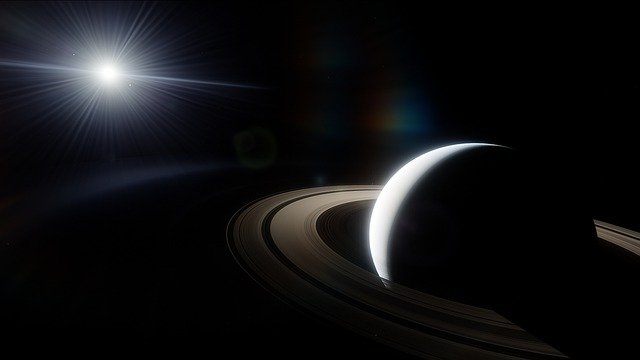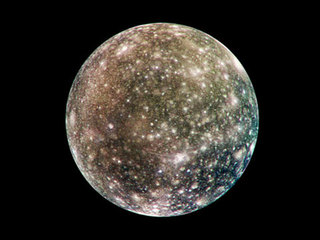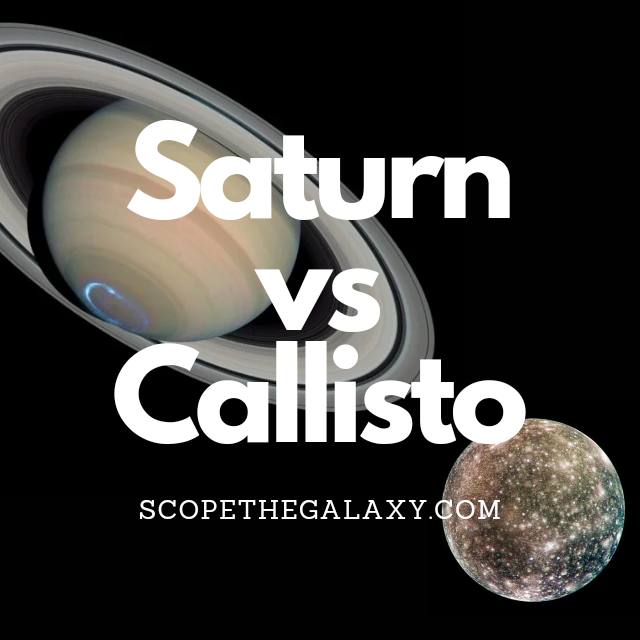*This post may contain affiliate links. This means we may make a commission if you purchase an item using one of our links*
The main differences between Saturn and Callisto would be that Saturn is the second largest gas giant in our solar system and has 82 moon orbiting it whilst Callisto is the 3rd largest moon in our solar system and has no other entities orbiting it and Callisto is recognized most by its heavily cratered body whilst it is recognized most by its yellow hue and clearly visible rings that surround it.
There are numerous other differences between the two so, continue reading for a more detailed look at each celestial body below along with a breakdown of their similarities and differences.
What Is The Planet Saturn?
Table of Contents

Saturn is the second largest planet in our solar system that has 7 rings surrounding its gaseous exterior. It’s also the 6th farthest planet from the Sun.
As Saturn falls under the gas giant moniker, the planet is mostly made up of gases. However, Saturn’s composition is a little different from Jupiter’s where its atmosphere is a mixture of hydrogen and ices containing elements of Ammonia.
It’s core on the other hand is comprised of a dense core of nickel and iron, which is then surrounded by rocks compressed so strongly that it allows the planets core to reach scorching hot temperatures of 11,700+ degrees Celsius.
On the other hand, It’s gaseous atmosphere is far cooler. The exterior generally sits in the extreme sub zero range where Saturn’s temperatures averages around -138 degrees Celsius.
This is generally constant throughout the yellow ringed giants day to day. In fact it’s much colder than even the coldest place on Earth, which would be Eastern Antarctic Plateau, Antarctica that hits -94 degrees Celsius, which is more than 40 degrees Celsius warmer.
Being so large (116,460km), Saturn’s gravitational pull is obviously strong. That’s why over it’s 4.5 billion years of existence, beyond its rings, this yellow gas giant has managed to accumulate 82 different moons along with other smaller interstellar debris that now orbit it.
In fact it’s largest moon Titan is literally bigger than one of the 8 planets orbiting the Sun, Mercury.
Saturn also orbits the Sun but, as the 6th farthest planet from it, it does mean a singular orbit will take it 29.4 Earth years to complete. In comparison to its axial orbit which only takes 10.7 hours, this is exponentially longer.
What Is The Moon Callisto?

Callisto is one of the large moons orbiting Jupiter, the outermost of the Galilean moons, first discovered on 7th January 1610. The surface of this icy world is frozen, but scientists believe an underground ocean could reside beneath the ice.
Even if there’s water on Callisto, it won’t necessarily hold life because the surface is so old. Scientists will need to conduct more research into the moon before determining whether this is a likely possibility.
The ESA’s JUICE (Jupiter Icy Moon Explorer) mission is focused on the three ice moons of Jupiter. It is expected to arrive in 2030 and will focus on learning more about the environment of each, as well as their potential for hosting life.
Scientists estimate that Callisto is around 4.5 billion years old (the same age as Jupiter), and its average distance from the Sun is approximately 778 million km. It has a diameter of 4820.6km, which makes it similar in size to the planet Mercury, and the average temperature is a frigid minus 139.2 degrees Celsius.
Callisto takes seven days to orbit its planet at an average distance of 1,880,000km, and it is tidally locked, meaning the same side of it always faces Jupiter. But this moon experiences less tidal influence than the other Galilean moons because it lies in the orbit of Jupiter’s primary radiation belt.
The name of this moon is derived from the stories of Greek myth. Callisto was the nymph who had an affair with Zeus, the King of the Gods. Upon hearing this news, Zeus’ wife Hera turned Callisto into a star and placed her in the Ursa Major constellation. Interestingly, every moon of Jupiter is named after a Greek figure who Zeus seduced.
Callisto may be the third biggest moon and similar in size to the planet Mercury, but it only has a mass of 107,593,737,963.819 billion kg. That may sound like a lot, but it’s only ⅓ the mass of the similarly sized Mercury.
You may wonder why scientists classify Callisto as a “moon” rather than a planet if it’s almost the same size as Mercury. The reason is simple; planets must orbit the sun, but Callisto orbits one of the planets.
The composition of this frigid world is around 60% rock and iron and 40% ice. The moon has roughly equal amounts of rock and ice, plus the potential for water below the surface. There are also traces of carbon dioxide, organic compounds, and silicates.
This moon is one of the oldest landscapes in the Milky way and the most heavily cratered body in our system. However, scientists believe this could now be a “dead” moon as there are no longer any signs of volcanism or plate tectonics on its surface.
How Are Saturn And Callisto Similar?
There are a few similarities that Saturn and Callisto share, which in this case includes the following:
- Both are a spherical shape.
- Both have a hotter core.
- Both are part of the same solar system.
- Neither have tectonic plates.
- Both orbit another object.
Differences Between Saturn And Callisto
In regards to the differences between the two, they include the following:
- Saturn is bigger with a diameter of 116,640km compared to Callisto’s diameter of 4,820.6km.
- Saturn has a magnetosphere whilst Callisto does not.
- Saturn has 82 moons orbiting it whilst Callisto has 0 objects orbiting it.
- Callisto orbits Jupiter in an elliptical pattern whilst Saturn orbits the Sun in an almost circular pattern.
- Callisto is tidally locked to Jupiter whilst Saturn isn’t tidally locked to any other object.
- Saturn has an atmosphere composed of hydrogen and helium whilst Callisto has a very thin carbon dioxide based exosphere.
- Callisto is one of the most heavily cratered entities in our solar system where it has 142 named craters with a lot more smaller one scattered throughout the moon whilst Saturn is a gas giant therefore, it doesn’t have a solid surface for craters to form.
- A day on Callisto takes 17 days whilst Saturn completes a day in 10.7 hours.
- Callisto’s density is 1.83 g/cm³ whilst Saturn’s density is the lowest amongst the gas giants at 0.687 g/cm³
- In regards to axial tilt, Saturn’s is 26.7 degrees whilst Callisto’s is practically 0 degrees.
- Saturn’s average temperature is -138 degrees Celsius whilst Callisto’s temperature is -139.2 degrees Celsius.
- As for mass, Callisto’s is 1.07 x 10^23 kg whilst Saturn’s mass is 5.683 × 10^26 kg.
- Saturn is a gas giant whilst Callisto is a low density terrestrial entity.
- Saturn has 7 rings surrounding it whilst Callisto has 0.
- Saturn’s gravitational strength is 10.44 m/s² whilst Callisto’s is 1.236 m/s².
- Saturn orbits the Sun in 29.4 years whilst Callisto orbits it in 12 years.
Summary
Although both entities are part of the same solar system and even if Callisto does orbit another gas giant, namely Jupiter, there isn’t very much that these celestial bodies have in common.
Whether it be in regards to their size, mass, physical composition, length of day and beyond, Saturn and Callisto are just designed to function very differently from one another.

